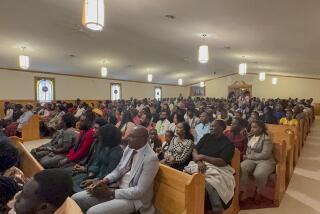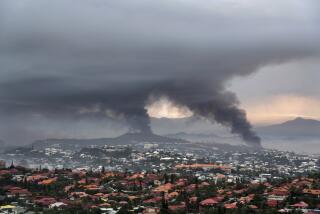At Haiti roadblock, a lesson in power dynamics
- Share via
Reporting from Carrefour, Haiti — They built the roadblock across the highway out of whatever they could find -- burning tires, the shell of a refrigerator, a rusty bed frame, a palm tree stump, a beaten-up camper shell and eight bodies, one in a makeshift coffin, another stuffed into a suitcase.
The young men of the Carrefour suburb of Port-au-Prince then furiously interrogated drivers Saturday about what they were carrying in their cars.
They were sick of people from the earthquake-wrecked capital dumping the dead on their streets in the middle of the night.
“There were only three people who died in this area,” shouted Pierre Maxim, 21. “The next day we wake up and see bodies all over.”
Roadblocks are common in Haiti, ranging in mood from tense civil disobedience to outright violence.
Saturday’s played out over two hours in a way that demonstrated, in almost perfect form, the dynamics of power in the country and even highlighted Haitians’ troubled love of Americans.
On a hot and cloudless morning, diesel exhaust and a fine cement powder cast a gray haze over the rutted strip of Route 2, a crucial artery out of Port-au-Prince lined by crumbling cinder-block storefronts.
Patron Wilfrenz, 28, said the young men who set up the roadblock were part of the “local brigade,” which protects the neighborhood in the absence of any meaningful law enforcement presence.
Such groups, under a variety of names and with varying amounts of weaponry, were empowered by populist former President Jean-Bertrand Aristide. They are seen as either freedom fighters or street gangs, depending on one’s point of view.
They have repeatedly shut down the country, most notably during the events leading up to Aristide’s ouster in 2004 and the subsequent election in 2006. Although they have been quiet lately, no one believes that they cannot mobilize in an instant.
On Saturday, about 20 of the young men, with more than a hundred others watching, became gatekeepers to the entire southern part of the country.
Around 9 a.m., a contingent of United Nations peacekeepers prepared to break up the roadblock. The Sri Lankan soldiers, based in the nearby rural town of Leogane, pulled their trucks right up to the barrier of corpses and junk. Eight of the blue helmets, armed with assault rifles, got out and screamed back and forth with the unarmed men about removing it.
Drivers on both sides of the roadblock agreed with the peacekeepers. “Let it through!” shouted a man driving a truck. Someone dragged away the camper shell. Another man ran up and shoved it back. “Block it off!” he yelled.
The eight soldiers moved in with their rifles about 9:30 a.m., barking and gesturing to get the roadblock out of the way. They eventually kicked the camper shell aside, and a few cars and U.N. vehicles got through.
Then the local brigade moved it back.
The eight peacekeepers stood about 20 feet away looking perplexed and a bit concerned. One talked on a radio. Another snapped a picture with his camera.
Two U.S. Navy helicopters circled overhead.
There was much furious screaming and gesturing between the brigade and drivers. They didn’t search the cars or trucks, but they did take cash. Those who paid got through.
A Toyota Land Cruiser blasted through, and ended up pushing the palm tree trunk away. The young men stopped the SUV and recovered the stump. The posturing and yelling and slipping of cash went on until about 10:15, when the two U.S. helicopters flew in low, approaching to land.
The giant gray Hueys came from the aircraft carrier Carl Vinson. There was no sign from below of their intention: Were they delivering relief, or Marines?
The crowd began to run, but not away. Hundreds poured across the highway and down a rutted dirt road to a rocky field along the shore, where a collapsed blue sloop listed in the surf.
The prop wash from the landing choppers kicked up grit and small rocks. The people kept running. They piled up at each copter door as the rotors wound down, grabbing and shouting words that the crews surely didn’t understand.
The Americans didn’t fly off, or open fire. They handed out boxes of bottled water.
When they had finished, they told everyone to back away, which they did, and flew off.
“They came to save our lives,” said Golen Parveles, a stout man in a faded golf shirt.
Americans have had a rough relationship with Haiti since the mountainous French colony became the second free republic in the New World after the United States. In modern history, Washington supported the brutal dictatorship of the Duvaliers as part of its Cold War chess game. And three U.S. administrations -- those of George H.W. Bush, Bill Clinton and George W. Bush -- took an inconsistent approach to Aristide and the army and paramilitaries who successively ousted him.
Still, Haiti’s hopes are always aimed at the U.S.
“After God, we believe in America,” said Charles Anes Adams, 34, gratefully drinking some of his water under a mango tree.
Back at the roadblock, about 80 yards away, two Haitian SWAT officers arrived and persuaded the brigade to move. “One hour! If they don’t come and get the dead bodies, we’re going to war!” declared Sierre Stanley, 25. “It’s been three days.”
They took down the roadblock, for the time being.
More to Read
Sign up for Essential California
The most important California stories and recommendations in your inbox every morning.
You may occasionally receive promotional content from the Los Angeles Times.











